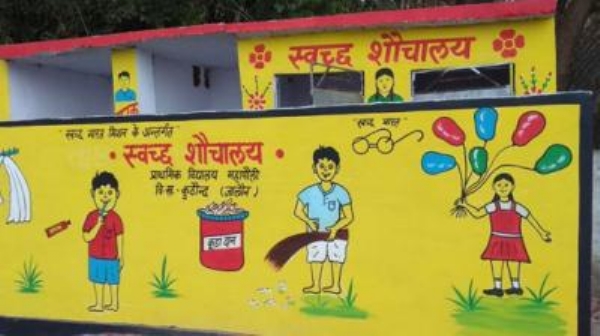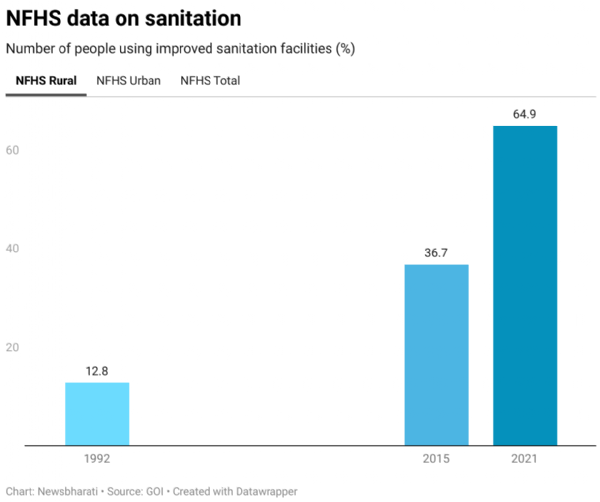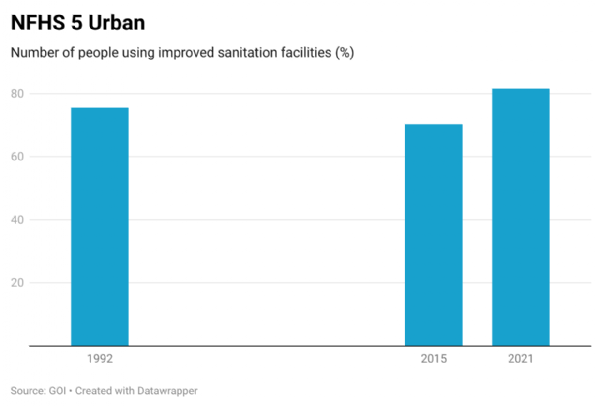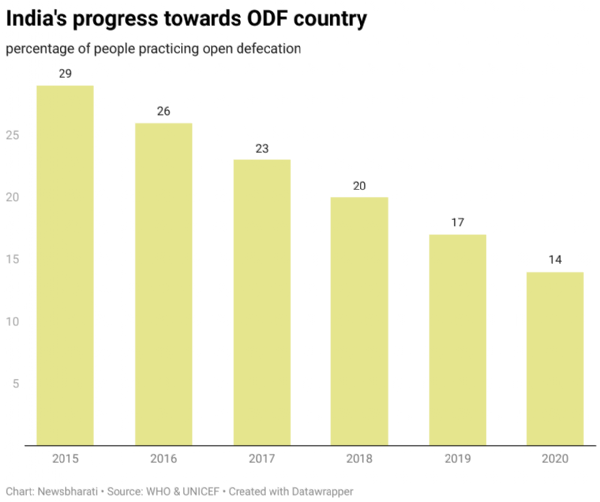India's gigantic steps towards ODF country
When India is growing as an economy, it is important that the Indian population remains healthy. Advanced sanitation facilities and awareness about hygienic practices are necessary to support India’s rapidly growing economy. This article specifically focuses on sanitation and India’s journey towards becoming an ODF country.
Total Views |
There is an old saying in English, ‘Health is wealth’. It is very accurate as an illness affects the capacity of a person to earn money. Health is an essential factor for living. In India, we have various practices through which we learn to maintain personal hygiene, but on the other hand, some practices are not at all hygienic eg. open defecation. India has been trying to become an open defecation-free (ODF) country for a long time. It grasped speed after 2014.

In the year 2014, the government of India launched a nationwide campaign called ‘Swachh Bharat Mission’. The campaign or mission was focused on making India clean and mainly open defecation free. The focus was on changing the habit of open defecation because open defecation comes with lots of problems. The effects of open defecation are on human beings, society and the environment. Therefore for the overall betterment of life, it was important to make India ODF. Under Swachh Bharat Mission, overall waste management was also covered and not only defecation. Capacity Building and Knowledge Management, solid and liquid waste management were other areas which were covered under Swachh Bharat Mission. To achieve the goal of ODF nation, providing toilets to every household was set as a target. The 150th birth anniversary of Mahatma Gandhi was set as a deadline for Swachh Bharat Mission. Today, after 3 years it is moving into its second phase. Before going further let's have a look at the problems associated with open defecation.
Also Read: India’s Grains Story
- Increase in Waterborne Diseases
- Vector-borne Diseases
Human waste attracts many insects like flies. These insects carry various parasites on their body. These parasites get deposited wherever they sit. Flies sit anywhere from human waste to open food and spread parasites and diseases along with them. So, open defecation causes various other types of diseases in the area.
- Compounding the Problem of Disease Exposure
The most dangerous part of open defecation is that it creates a cyclic form of problems. For instance, open defecation creates diarrhoea. It reduces people’s capacity to go far distances and they had to pass the waste wherever they have bowel attacks. This begins a vicious cycle as people defecate in the open more and more and causes these contagious diseases to spread more; which causes more and more people to defecate in the open and keeping the vicious cycle going on.
- Malnutrition in Children
Open defecation affects the nutrition of the children in the area. Due to open defecation, children are prone to frequent diseases. The frequent illness affects the growth and nourishment of the children which also affects them psychologically.
- Gender-based violence
In the absence of private latrines, women and girls are usually prone to gender-based violence in such areas. As they have to go in the open for natural calls, it puts them in the risky situation of being threatened by anti-social elements.
Also Read: How India makes steel for the world
These were some problems which one can easily find. There are several other effects of open defecation on the environment as well. Deep studies have revealed the social aspect of open defecation as well, and hence creating awareness for using private toilets and providing toilets became a priority for the government in 2014. One of the best ways to understand the progress of the nation is to look at NFHS data. NFHS is a vast nationwide survey conducted by the government which contains hundreds of indicators related to health and it can help us to get some idea about how India has progressed in the direction of becoming an ODF nation.
National Family Health Survey (NFHS) is conducted in India since 1992 after every 5 years. The only time it was missed was in 2010 when NFHS 3 was conducted in 2005 and NFHS 4 was conducted in 2015. The latest NFHS 5 survey was out in September 2021.
NFHS 5 highlights
- 17 Field Agencies gathered information
- The international institute of population science was the nodal agency
- 636,699 households, 724,115 women, and 101,839 men covered.
- Data collected on 131 indicators
- measurements of height, weight, and haemoglobin for children, and measurements of height, weight, haemoglobin, blood pressure, and random blood glucose for women and men.
For this article, we would be looking only at sanitation, as it impacts various other aspects as explained before. Therefore, we are referring to one indicator which is the number of population living in households that have improved sanitation.
The sanitation situation is a little bit better in urban areas than in rural areas. In urban areas, most of the houses have proper latrines and buildings/apartments or houses have the separate sewage-carrying infrastructure. For the poor people, many local governing bodies provide common toilets. Yet, there was a scope for a lot of improvement which can be noticed in the 2021s report.
On the other hand, the problem of sanitation was more serious in rural areas. Traditionally, people practice open defecation and sadly it had a very common acceptance. Since the introduction of the Swachh Bharat Mission, there has been a change. The following map shows the change in the percentage of households that use proper sanitation facilities.
_202210302337395190_H@@IGHT_0_W@@IDTH_600.png)
As the map explains, a small state like Sikkim has done marvellous progress between NFHS 4 and NFHS 5. The change is ranging between 9%to 10%. Now let’s have a look at the present situation, i.e. a map of the percentage of the population living in households that use proper sanitation facilities as per NFHS 5 data.
-(2)_202210302340526464_H@@IGHT_0_W@@IDTH_600.png)
Currently, we can see that Kerala has the largest population percentage living in households with improved sanitation facilities.
Also Read: India in Space
The difference is very significant in rural areas and urban areas. The percentage of the number of people using improved sanitation facilities in a rural areas has increased from 12.8% to 64.9% in 2021.

On the other hand, in urban areas, many people were already living in households with improved sanitation facilities. Hence, the growth is not much in urban areas.

As the chart explains, urban areas in fact had better conditions in 1992 which slightly deteriorated by 2015. It improved very well and the number of people using improved sanitation facilities rose slightly over 80%.
Overall India had performed very well towards becoming an ODF nation. The percentage of the population practising open defecation is reducing constantly year by year.

Globally, India yet had to run a long race to become completely ODF. The data from the world bank shows that there are still 95 countries where open defecation is in practice. With all the rapid progress India made in the last 5 years, it is now number 33. Still, quite a way to go to join those 140+ countries which are ODF. As we are seeing through data and numbers, India is taking promising steps to join those 140+ nations which are ODF.
In this article, we have a glimpse towards India’s gigantic steps towards becoming an ODF country. There are several other aspects and indicators of NFHS. One aspect might impact other. In other articles, we can see the correlation between other indicators with each other.


